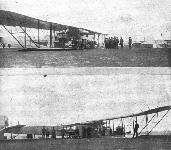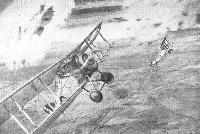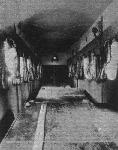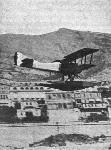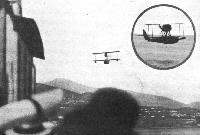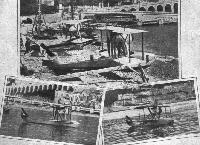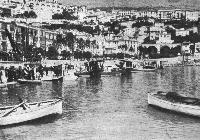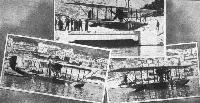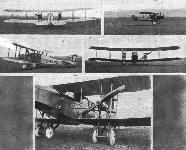Фотографии
-
Two views of a Sikorsky biplane, fitted with four 160 h.p. German Argus motors, after a bad landing
Самолёты на фотографии: Сикорский Илья Муромец - Россия - 1913
-
ARMOURED SCOUTS ZOOMING.
Самолёты на фотографии: Sopwith Salamander / T.F.2 - Великобритания - 1918
-
The interior of the Handley Page W.8 as fitted up for ballast tanks when up for record
Самолёты на фотографии: Handley Page H.P.18 (W.8) / H.P.30 (W.10) - Великобритания - 1919
-
"Vickers-Vimys" for China: Erecting the cabins: A large batch of Vickers-Vimy-Commercials are now being completed at Weybridge for the Chinese Government. Our photograph gives a good idea of the absence of cross bracing inside the cabins of these machines
Самолёты на фотографии: Vickers Vimy Commercial - Великобритания - 1919
-
The silver model, to scale, of the Vickers-Vimy-Rolls aeroplane presented to Dr. Chalmers Mitchell by The Times to commemorate the first attempt to fly from Cairo to the Cape. Four smaller models of the machine were presented to the pilots and mechanics, Capt. S. Cockerell, Capt. F. C. Broome, D.F.C., Sergt.-Major James Wyatt, and Mr. Claude Corby. All these beautiful models are the work of the Goldsmiths and Silversmiths Company of Regent Street
Самолёты на фотографии: Vickers Vimy Commercial - Великобритания - 1919
-
SUPERMARINES FOR NORWAY: Our photographs show two of the batch of Supermarine flying boats ordered by the Royal Norwegian Navy. The machine on the left is fitted as a three-seater with special dual control, and will be used as a school machine at the Norwegian naval seaplane base at Horten. The machine shown on the right is of the standard four-seater Channel type, which has proved so successful. Fitted with a Beardmore engine of 160 h.p. only, this machine gets off and alights well with four up, which is no mean performance. The inset shows one of the machines moored to a buoy after completing its trial flights. It is interesting to know that when a complete squadron of these boats has been delivered, they will be used on behalf of the Norwegian Government in conjunction with a private civil aviation enterprise to carry out passenger and mail service between Christiania and Christiansand. A number of officers of the Norwegian Naval Air Service have been given a course of instruction on the Supermarine flying boats. They are all experienced seaplane pilots, and are now fully qualified flying boat pilots
Самолёты на фотографии: A.D. Flying Boat - Великобритания - 1916
-
A standard Spad, piloted by Ensign Tece, which was to have taken part in the speed race, but was prevented by engine trouble
Самолёты на фотографии: SPAD S.XII / S.XIV - Франция - 1916
-
A very excellent flying boat: The standard Savoia S.13 on which Janello gave some wonderful exhibitions of trick flying, including looping, spinning, rolls, Immelmann turns, side-slips, etc.
Самолёты на фотографии: SIAI S.8 - S.13 - Италия - 1917
-
AT MONACO: Janello, on the Savoia racer, coming in over the Tir aux Pigeons at the finish of the race. Inset: The Savoia racer alighting
Самолёты на фотографии: SIAI S.8 - S.13 - Италия - 1917
-
AT MONACO: Three views of the splendid little Savoia racer flown by Janello in the speed race on Sunday, April 25, 1920
Самолёты на фотографии: SIAI S.8 - S.13 - Италия - 1917
-
AT MONACO: A row of flying boats in the harbour. Reading from left to right the machines are: Racing Savoia, T.157 Hispano, H.13 Sunbeam, F.B.A., and H.15 Sunbeam
Самолёты на фотографии: SIAI S.8 - S.13 - Италия - 1917
-
Three of the G.L. flying-boats of the French Naval Air Service which were starting for Bizerta. The upper photo shows No. 40, which was waterlogged, and was later broken up and taken away in bits by souvenir hunters, the engine being salved. The other two illustrations show Nos. 41 and 42, both of which started for Bizerta, No. 41, piloted by Bellot, being the only machine to make the double crossing
Самолёты на фотографии: Levy-Lepen GL.40 / HB.2 / R - Франция - 1918
-
Регистрационный номер: G-EAPC TEN PASSENGERS ON 320 HORSE-POWER: A Central Aircraft Co. cabin machine at Northolt. Our photographs show the machine in front, rear, and three-quarter rear views. The lower picture shows the cabin and one of the 160 h.p. Beardmore engines. In the top right-hand corner the machine is seen taking off with eight people and 400 lbs. of sand on board, piloted by Lieut. F. T. Courtney
Самолёты на фотографии: Central Centaur IIA - Великобритания - 1919
-
THE THREE-ENGINED (CLERGET) CAUDRON PILOTED BY MAICON: This machine had to retire for repairs to her floats, which were leaking badly
Самолёты на фотографии: Caudron C.25 - Франция - 1919
-
TWO VIEWS OF THE TELLIER-NIEUPORT-SUNBEAM BOAT PILOTED BY M. LECOINTE : The photo, on the right shows the machine coming in after passing its altitude test
Самолёты на фотографии: Tellier Tellier-200 - Франция - 1916
-
The Tellier-Hispano boat, piloted by Hurel, which is taking part in the flight to Tunis. This machine has two Hispano engines, one driving a tractor and one a pusher. In other respects it is similar to Lecointe's machine
Самолёты на фотографии: Tellier Tellier-200 - Франция - 1916
-
AT MONACO: de Romanet, on the Spad, winning the speed race. Inset: The machine getting off at the start of the race
Самолёты на фотографии: Bleriot-SPAD S.26 - Франция - 1919
Статьи
- Flight
